November 12, 2010
Air Date: November 12, 2010
FULL SHOW
SEGMENTS
Reworking the Ozone Treaty to Work for Climate Change
View the page for this story
In 1987 the international community came together in Montreal to agree on limits to ozone-depleting chemicals. More than two decades later, organizers like Durwood Zaelke, president of the Institute for Governance and Sustainable Development, are looking to see how lessons learned from that success might be applied to climate change. He talked with host Bruce Gellerman. (07:45)
Code Red for Gulf Coral
View the page for this story
Deep in the Gulf of Mexico, scientists have discovered an ecosystem in collapse. Two biologists from Temple University, Dr. Erik Cordes and graduate student Andrea Quattrini, tell Bruce Gellerman what they’ve seen and what it means for aquatic life in the Gulf. (04:10)
Gas Drillers are Pumped Up
/ Jeff YoungView the page for this story
Natural gas is emerging as a winner among energy sources in the recent election. From Congress to key gubernatorial races, the political landscape favors expanded use of natural gas. LOE’s Jeff Young tells us that poses challenges and opportunities for the environment. Gas is cleaner than coal or oil and emits far fewer greenhouse gases. But a drilling boom raises concerns about water quality. (06:00)
Building Up: Vertical Farms
View the page for this story
Professor Dickson Despommier worked with his students at Columbia University to come up with an innovative way to make cities more sustainable. They came up with the vertical farm — a skyscraper of greenhouses. LOE’s Steve Curwood talks with Despommier about how vertical farms could help solve environmental problems associated with agriculture. (07:00)
SNAP to the Farmers’ Market
/ Jessica Ilyse KurnView the page for this story
The Supplemental Nutrition Assistance Program, known as SNAP, provides low-income Americans with assistance to buy food. The city of Boston is providing even more help, and creating extra incentives to encourage healthy eating. LOE’s Jessica Ilyse Smith went to a farmers’ market to find out about the Boston Bounty Bucks program. (05:00)
Listener Letters
View the page for this story
Living on Earth fields listeners’ complaints, corrections and compliments. (02:40)
Protecting Abundant Water
/ Andrew StelzerView the page for this story
Michiganders don't have to worry much about having an adequate supply of water. But efforts by Nestlé to bottle water in the state, and the prospect of drier times in a climate-changed future, are leading some residents to try to put Michigan groundwater under permanent protection. Andrew Stelzer reports. (07:15)
Carbon Credit Card
View the page for this story
The South Pacific island of Norfolk is taking part in a groundbreaking experiment for reducing personal carbon emissions. Dr. Garry Egger of Australia’s Southern Cross University is giving islanders a carbon budget - rewarding residents that stay under their allotment. But, as he tells host Bruce Gellerman, his idea has come under attack. (05:55)
EarthEar
View the page for this story
Budgies tweet from Australia. (01:00)
Show Credits and Funders
Show Transcript
HOST: Bruce Gellerman,
GUESTS: Durwood Zaelke, Erik Cordes, Andrea Quattrini, Dickson Despommier, Garry Eggers
REPORTERS: Jeff Young, Steve Curwood, Jessica Ilyse Smith, Andrew Stelzer
GELLERMAN: From Public Radio International - this is Living on Earth. I’m Bruce Gellerman. Could an international treaty designed to save the planet from one cataclysm also save us from global warming?
ZAELKE: The Montreal Protocol has been the best treaty in the environment that we've ever created because of its success protecting the stratospheric ozone layer but it's also the best treaty we've ever created for protecting the climate.
GELLERMAN: Coming up: Ronald Reagan called the Montreal Protocol a “magnificent accomplishment”- but if it were used to tame climate change today, would Republicans sign on? Also, we drill down on energy and the midterm election results.
TUCKER: It’d be easy – it’d be an easy analysis to put together to say oh, well Republicans win so therefore we’re good to go, we’re just gonna drill everywhere. Well, that’s just not the case.
GELLERMAN: Natural gas and the GOP – drill baby drill heads to Capitol Hill. These stories and more, just ahead on Living on Earth. Stay with us.
[THEME]
Reworking the Ozone Treaty to Work for Climate Change

Delegates from 196 nations met in Bangkok to discuss further advancement of the Montreal Protocol. (Photo: IISD Reporting Services)
GELLERMAN: From the Jennifer and Ted Stanley Studios in Somerville, Massachusetts - this is Living on Earth. I’m Bruce Gellerman. A comprehensive climate- energy bill is dead in Congress, and the mid term elections put the final nail in the coffin.
OBAMA: It’s doubtful you could get the votes to pass it through the house this year, or next year, or the year after.
GELLERMAN: But wait - don’t bury climate change legislation just yet says President Obama:
OBAMA: Cap and trade was just one way of skinning the cat. It was not the only way, it was a means not an end.
GELLERMAN: Another means may be the Montreal Protocol. In 1987 the nations of the world came together in Canada and agreed to save the planet from a chemical catastrophe. They signed a historic treaty to phase out compounds that were destroying the world’s protective ozone layer. Now, 23 years later, delegates are meeting in Bangkok to discuss if the Montreal Protocol can be repurposed to save us from climate changing gases. Durwood Zaelke is at the meeting. He’s president of the Institute for Governance and Sustainable Development.
ZAELKE: Today many people look back after they see the success of the Montreal Protocol and they say: ‘that was easy.’ It wasn’t easy, it was a tremendous struggle to get the political alignment, and in fact the treaty started in a very, very modest way.

Delegates from 196 nations met in Bangkok to discuss further advancement of the Montreal Protocol. (Photo: IISD Reporting Services)
GELLERMAN: Well give me a history of the Montreal Protocol back in 1987, what was it designed to do and how did it do it?
ZAELKE: The Montreal Protocol was designed to phase out dangerous chemicals that were destroying the stratospheric ozone. Or rather, that were thought to be destroying the stratospheric ozone layer, because when the treaty was originally negotiated, we did not yet have empirical evidence that these suspected chemicals- the CFC’s or chloroflorocarbons- were actually doing what the scientists thought that they were doing.
We thought that these were modern chemicals that societies could not do without. They were used in about 240 industry sectors, and there were billions of dollars at stake and there were hundreds of thousands of jobs and there was powerful opposition. The two scientists who first hypothesized that the CFCs were destroying the stratospheric ozone layer, Dr. Sherry Rowland and Dr. Mario Molina, were vilified by industry. They were parodied in popular press, they were the object of counter scientific articles. They struggled mightily until later they won the Nobel Prize for their brilliant deduction that the CFCs were destroying the ozone layer.
GELLERMAN: So despite all this opposition, the Montreal Protocol was incredibly successful, am I right?
ZAELKE: Montreal Protocol is the most successful environmental treaty that the world has ever created, bar none. It is phased out 96 chemicals by more than 97%. If we had not phased out these chemicals, we would suffer millions of cases of skin cancer, millions of cases of cataracts, tremendous damage to our agricultural sector, and no one on the planet would be able to stay outside for more than 10 minutes without receiving a severe sunburn. That’s how serious the threat was.
GELLERMAN: So while Montreal was designed to deal with the ozone hole, it’s been able to do what no other international treaty has been able to do, which is to curb greenhouse gasses.
ZAELKE: It’s very important to understand that most of the chemicals that destroy the ozone layer are also powerful greenhouse gasses. The Montreal Protocol, while it was solving the stratospheric ozone problem, also has solved an amount of the climate problem that otherwise today would be equal to the contribution of CO2, which is the dominant factor in climate change.
It has done five to ten times more than the Kyoto Protocol is striving to do in terms of reducing climate emissions. That’s a tremendous success. So, now we see that this treaty has done the best job in the world for climate, and the parties are asking- what more can it do for climate?
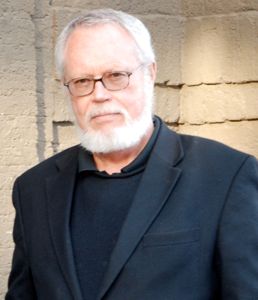
Durwood Zaelke is President of the Institute for Governance and Sustainable Development. (Photo: IGSD)
GELLERMAN: So the idea is to amend the Montreal Protocol so that it deals with these super-greenhouse gasses, HFC’s. Will that require Congress to re-ratify the treaty?
ZAELKE: It will. They’ll have to ratify the amendment. All the parties will have to ratify the amendment. It’s a pretty good bet in the United States- you have to remember that this treaty was started under President Ronald Reagan. It has always enjoyed strong bipartisan support in the Congress. We’re pretty confident that even in the more conservative Congress that we’ve been given after the recent election, will agree to ratify.
GELLERMAN: Do you ever look back and say- well, 1987, Ronald Reagan, a Republican was president, we had uncertain science about the ozone hole, tremendous ideological opposition, deep vested interest and lots of jobs at stake, and yet the world moved rapidly to a treaty and a successful treaty at that. Do you ever say, ‘Wow! How did we do that and why can’t we do it now?’
ZAELKE: I think you’ve posed the central question for climate change. What can we learn from the Montreal Protocol? I think the first lesson, the central lesson, is start and strengthen- start, get experience in solving the problem. Gain some confidence that you know what you’re doing. Then, do more of what works. You know, we’re so polarized in the climate debate that we’ve tied ourselves in knots. And that’s partly because we tried to do everything in one international negotiation- in hindsight, probably not a good idea.
Richard Benedict, who negotiated the Montreal Protocol originally for the United States, has compared the climate negotiations to a medieval fair. Fire eaters and jugglers and every kind of clown you can imagine. You cannot negotiate as efficiently in that kind of a context. It’s a different time, but it’s not so different that we can’t reproduce this if we disaggregate the climate problem, take the lessons of Montreal, and solve pieces of this problem as we go forward with unique governance systems that develop the expertise to solve that part of the problem.
GELLERMAN: Well, Mr. Zaelke, I want to thank you very much. I really appreciate it, and I learned a lot.
ZAELKE: Good! My pleasure.
GELLERMAN: Speaking to us from Bangkok, Durwood Zaelke, president of the Institute for Governance and Sustainable Development.
Related links:
- Institute for Governance and Sustainable Development
- United Nations Environment Program- Ozone Secretariat
[MUSIC: Soulphonic Soundsystem “Eastern Market” from Soulphonic Soundsystem Vol 1 (Convincing Woodgrain 2007)]
Code Red for Gulf Coral
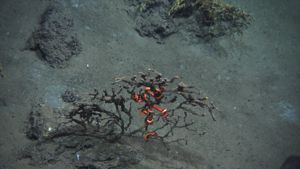
Dying coral. (Photo: Lophelia II 2010--BOEMRE and NOAA-OER)
GELLERMAN: Deep in the Gulf of Mexico, just seven miles from the site of the BP oilrig disaster, scientists have discovered an ecosystem in collapse. Pictures taken by a submersible robot, forty-six hundred feet down, show images of dead and dying corals on the muddy seafloor. Among those studying the images is Erik Cordes, a biologist from Temple University and his graduate student Andrea Quattrini, who was aboard the surface vessel when the photos were taken.
QUATTRINI: We hit the spot and all the coral colonies attached to this area- most of them were already recently dead or dying. Most of the colonies, about 50 percent of all of the colonies, you could see tissue sloughing off, and dead skeleton with no live tissue.
CORDES: I was really saddened by this news. We hadn’t seen anything that was visually compelling like this. I think we were all hoping that the deepwater corals had somehow dodged a bullet here.

Temple University biologist Erik Cordes explores the Gulf of Mexico in search of new, deep coral formations. (Photo: Peter Batson, Deep Ocean Photography)
GELLERMAN: When you say corals sloughing off this tissue- I think most people think of coral as like a rock…
CORDES: A coral is a living animal. It has a calcium carbonate skeleton with a very thin layer of tissue covering the entire thing. And, in this case, you could see the skeleton, and the tissue actually falling off of the skeleton.
GELLERMAN: It sounds gruesome!
CORDES: It was a bit gruesome. It was a very sad sight. To see something like this was really clear evidence that there was a catastrophic event that caused this.
GELLERMAN: And you think its oil that killed them?
QUATTRINI: Well, we don’t really know quite yet what happened, but some of the evidence is pointing to the Horizon incident.
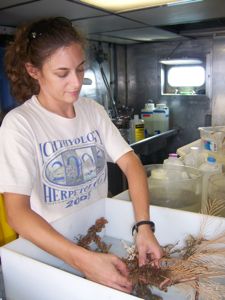
(Photo: Jennie McClain and Lophelia II 2009)
CORDES: In 15 years of studying deep-sea corals, and a lot of my time in the Gulf of Mexico, this does not look like it could have been caused by a natural occurrence.
GELLERMAN: Now, could it be from the dispersant and not from the oil?
CORDES: We actually don’t know exactly what caused it. It’s likely that there were some toxins present that caused this reaction by the corals, but was most likely the combination of the oil and the dispersant.
GELLERMAN: Are you finding this in just this one area near the wellhead? Or are you finding it at other coral colonies?
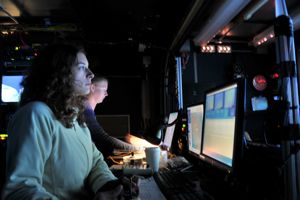
(Photo: Erik Cordes and Lophelia II 2009)
CORDES: So, we got to see this one site, there are a lot of other sites in the area that we know have the potential to have these coral communities on them. In fact, about 25 that some of our collaborators have picked out within a ten-mile radius of the Deepwater Horizon where we’re likely to find more corals. We will be going back in about three weeks and we’ll be visiting more of these sites and looking for more of this evidence.
GELLERMAN: So, Dr. Cordes, what are the long-term effects of this?
CORDES: Well, the recovery of these corals is gonna to take a really long time. They’re really slow growing. Everything in the deep sea tends to get slowed down, mostly because it’s so cold. Some of the coral’s related species to grow that large would take at least decades to even centuries.
GELLERMAN: My next question is an insensitive question: Why should I care?
CORDES: That’s a question I’ve been hearing a lot recently. Just like the shallow water coral reefs, the deep-water corals create a lot of habitat for other organisms. There’s a high diversity down there, there are a wide variety of species. There’s also a direct connection between the deep water corals and the shallow water ecosystem in the Gulf of Mexico- all of the corals are reliant on the productivity of the surface for all of their food- so there’s a direct tie there.

(Photo: Lophelia II 2010: BOEMRE and NOAA-OER)
There are also a lot of species that live in shallow water that will actually migrate down to the depths during the day to try to hide in the dark and avoid predation. And they interact directly with these deep-water reefs and then return to the shallow water. Anything that happens in deep water is going to have repercussions in the shallow water and in the wider ecosystem of the Gulf.
GELELRMAN: Well, I want to thank you both very much. I really appreciate it.
CORDES: Sure, it was good talking to you.
QUATTRINI: Yeah, thanks a lot!
GELLERMAN: Biologist Erik Cordes from Temple University and his graduate student, Andrea Quattrini.
[MUSIC: Marco Benevento “RISD” from between Needles And Nightfall (Royal Potato Family 2010)]
GELLERMAN: Just ahead, natural gas is booming – and a new, fossil fuel- friendly Congress is ready to open the tap. Keep listening to Living on Earth!
Related link:
Cordes Laboratory
[CUT-AWAY MUSIC: Will Bernard “Blister” from Blue Plate Special (Palmetto Records 2008)]
Gas Drillers are Pumped Up

Natural gas emits half the greenhouse gases of coal and about a third less than oil for the same amount of energy. (Jean Schweitzer)
GELELRMAN: It’s Living on Earth, I’m Bruce Gellerman. Big news, now, about natural gas: These days it’s almost as cheap as coal, due in part to a new method of drilling called hydraulic fracking. Drillers pump water and chemicals deep into underground shale formations and blast the natural gas out.
Halliburton developed the method, now the EPA has subpoenaed the company for refusing to disclose which chemicals they’re using. Meanwhile there’s a gold rush on for the natural gas locked in the Marcellus Shale formation in Pennsylvania. Big oil companies have been gobbling up independent gas frackers there. In the latest deal, Chevron just bought Atlas Energy for 4 billion dollars. The other big natural gas news was Election Day. Living on Earth’s Jeff Young looks at the political landscape, and finds it good for gas.
YOUNG: The day after his election “shellacking” President Obama took a question at a press conference: where can Republicans and Democrats find common ground? Energy, the president said, and he emphasized one specific form of energy.
OBAMA: We’ve got terrific natural gas resources in this country. Are we doing everything we can to develop those?
YOUNG: Not far away, on Washington’s K Street, Chris Tucker and his officemates liked what they heard.

Marcellus shale gas drill in Pennsylvania. The frack drilling boom there has sparked fears of water contamination and a fractured landscape. (Photo: Ruhrfisch)
TUCKER: We all sort of looked around at each other and said, yeah, he’s right. Then our second reaction was, wow, we can’t believe he just said that! (Laughs)
YOUNG: Tucker is with a group called Energy In Depth, which does public relations work for independent natural gas drillers. Tucker says it’s not that surprising that the president should turn to natural gas. There’s already bipartisan support for using the huge supplies coming online, and Tucker says the industry’s wish list is a short one.
TUCKER: We actually don’t need a whole lot of policy. We don’t need tax breaks or handouts or bailouts or… we just need to be able to do it. We just need to be able to have rules in place that work, we need to have regulations in place that are stringent but at same time that we can predict.
YOUNG: Congressional Democrats had pushed legislation to limit possible water contamination from hydraulic fracturing of shale gas. But many of that bill’s co sponsors lost on November second. Republican strategist Karl Rove told a recent gas industry conference that Republican victories mean the industry need not worry about more regulation. Tucker says that sounds premature and perhaps counterproductive.
TUCKER: It’d be an easy analysis to put together to say, oh, well, Republicans win so, we’re good to go, we’re just gonna drill everywhere. Well that’s just not the case.
YOUNG: Tucker says the EPA is in the midst of a thorough review of hydraulic fracturing and some companies are voluntarily disclosing fracking chemicals. And concerns about water quality are likely more regional than partisan. The industry prefers to keep regulation at the state level and that means state election results could have a big impact, especially in Pennsylvania. The Keystone state elected a Republican legislature and governor. And Pennsylvania is at the cutting edge of a drilling boom.
JARRETT: Right now we’re having a gas rush. We happen to have the mother of all natural gas deposits under our feet in the Marcellus Shale deposit.
YOUNG: Jan Jarrett leads the environmental group Penn Future. She notes the gas industry has given nearly a million dollars to governor-elect Tom Corbett over his political career.
JARRETT: The drilling industry spent at least three million in campaign contributions. We would hope that does not change the administrations stance on environmental protection and oversight of an industry that has a really big impact.
YOUNG: Pennsylvania’s outgoing Democratic governor, Ed Rendell, placed a moratorium on new drilling leases on state forestland. Corbett says he’ll rescind that.
Pittsburgh Post-Gazette columnist Brian O’Neill has been writing about another aspect of natural gas and state government. Pennsylvania has no severance tax on drilling.
ONEILL: Everybody’s got one but us. As I said in an earlier column, there’s only two places without this tax: Pennsylvania and Fantasyland.

Natural gas emits half the greenhouse gases of coal and about a third less than oil for the same amount of energy. (Jean Schweitzer)
YOUNG: With the state looking at a multi-billion dollar deficit, O’Neill wonders where money will come from for, among other things, the Department of Environmental Protection.
ONEILL: That’s a serious concern to a lot of people. I mean there are real environmental issues and I don’t think the state is prepared to deal with it right now.
YOUNG: While many grassroots environmental groups are focused on the potential damage from drilling, some Washington environmental groups want to expand the use of natural gas, because it’s much cleaner burning than coal or oil. That’s created considerable tension within the environmental community. Dan Weiss directs climate strategy at the Democratic-leaning think tank, Center for American Progress.
WEISS: Both groups who want to use more natural gas and those who want additional protection are correct. Nat gas produces 50 percent less global warming pollution compared to coal and about one third les compared to oil. So the expansion of natural gas as a fuel can really reduce emissions by a sizeable amount.

A garbage truck powered by natural gas. Each one saves the equivalent greenhouse gas emissions of hundreds of cars. (Jeff Youngstrom)
YOUNG: Weiss’s group did a study that found a shift to natural gas for big trucks could cut oil use by a million barrels a day--about five percent of our current use. But Weiss is also concerned about lax regulation on drilling. He sees opportunity to do both.
WEISS: In any natural gas program that moves forward, that encourages the use of more gas, needs to also include additional protections. It ought to include requirements that companies report on toxic chemicals they use to produce the gas, and they ought to make sure they protect the drinking water and air quality.
YOUNG: So can natural gas fuel some bipartisan cooperation? The first test could come in the lame duck session of Congress. The Senate is set to vote on a bill to use more natural gas for heavy-duty trucks. The co sponsors are Democratic leader Harry Reid and arch-Conservative republican Tom Coburn. For Living on Earth, I’m Jeff Young.
Related links:
- EPA’s Hydraulic Fracturing Study
- Center for American Progress report on natural gas powered vehicles
- Energy In Depth represents the gas drilling industry
- Penn Future’s information on drilling impacts in Pennsylvania
[MUSIC: Solsonics “Ascension” from jazz In The Present Tense (Crysalis Records 1994)]
Building Up: Vertical Farms
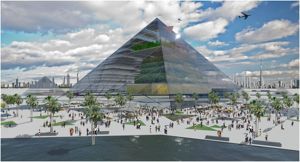
A vertical farm that Dr. Despommier helped conceptualize with Eric Ellingsen. (Photo: Eric Ellingsen and Dr. Dickson Despommier.)
GELLERMAN: More than half the world’s population lives in cities.
DESPOMMIER: In reality, the city has assumed the role of a monstrous parasite when viewed from an ecological perspective.
GELLERMAN: That unflattering assessment of today’s city comes from microbiologist and public health professor Dickson Despommier. Despommier's new book is “The Vertical Farm: Feeding the World in the 21st Century.” Despommier says growing crops hydroponically, without soil in high rise buildings could be the way to go. He told Living on Earth’s Steve Curwood he was inspired by his students at Columbia University.
DESPOMMIER: A full class of students that didn’t want to hear anymore of gloom and doom about the environmental destruction that was going on outdoors- they said, ‘we want to work on something more positive.’ So, I let them. I said, this is your money, this is your time, what would you like to do? About a week later they came back to me and they said, ‘We think rooftop gardening in NYC would be a good idea.’ So, I said, ‘Great. Tell me how many acres of rooftops we’ve got, tell me which crops you would grow, and tell me how many people you can feed with 2,000 calories per day per person.’
They answered that question and they could feed about two percent of Manhattan only. So, I said wait a minute, now don’t get discouraged here. Take your idea off the roof and move it into the building itself. Let’s talk about how many floors of a building you could actually do this in. That began the discussion.
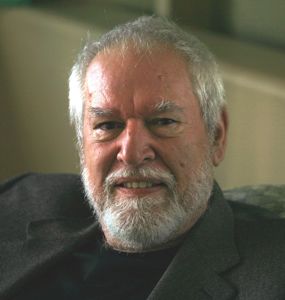
Author Dickson Despommier. (Photo: Marlene Bloom)
CURWOOD: So, if I were to be standing in front of a vertical farm, my eyes closed, and I open them- what would I see?
DESPOMMIER: Oh, you’d be amazed. You’d be absolutely amazed. First of all, you wouldn’t see the building, because all you would see would be the plants growing inside of a totally transparent building. It would look like the plants were being suspended in midair, and they were growing on…you couldn’t actually tell what they were growing on. And, in fact, they’re not growing in soil at all, they’re being grown hydroponically.
CURWOD: Where do you get the nutrients if you use hydroponics?
DESPOMMIER: So, all you have to do is line up all the chemicals that plants need, and all the chemicals that humans need- which is about 6 more than plants need- and combine them together in the right ratios, dissolve them into water and feed them to your plants. Most people would cringe when they hear that for the first time, but no one would cringe if I told you it’s just like using Miracle Grow on your plants. ‘Oh yeah, I understand that part.’

A vertical farm proposal. (Photo: Romses Architects)
CURWOOD: How feasible do you think this is, Professor? I mean, what are the present examples of vertical farms?
DESPOMMIER: Well, there are none, as we speak. But, I can almost guarantee you that within a year from now, there will be many. The country of Qatar has an enormous interest in this. China, India- they’re very interested in food security and food safety. They want food that’s produced by themselves, and if you live in Qatar, that’s not going to happen unless, somehow, you import all the soil.
Even then, you don’t have the right climate for all of this. So, everything that they’re going to do has to be done indoors. If you go around the world and you say ‘where would vertical farming fit in beautifully into the needs of those places,’ you can find places like Iceland that have no soil, basically, whatsoever. They have six months of darkness, how can they possibly grow anything there? If you grow it in-doors, and you use geothermal energy for your grow lights, the next thing you know you’ve got vertical farms going up.
CURWOOD: So, in the vertical farm, how do you deal with the waste?
DESPOMMIER: Right! Well, we don’t call it that- we call it unrealized energy. Let’s take corn for an example. I would take that part we don’t eat. I would dry it down to completion, I would then powder it and I would run it through a device, which is currently in use throughout Japan called the plasma arc gassifier.
And what that does, is it takes any solid material and reduces it back to its elements. And what you get back from that device is the energy to run the device, first. You get no residual material that you have to worry about, and the last thing that you get back, which is much more important, is that you get some product produced by this process that you can then use in the form of a gas to burn and to create carbon dioxide water and heat. And the heat is then used to generate energy. The carbon dioxide and water can be fed right back into the vertical farm. It’s a closed-loop agricultural system, basically.
CURWOOD: Ok, today’s agriculture and new food movement is predicated on a couple of things- organic agriculture, locality and seasonality- what about thinking of June and strawberries, that sort of thing?
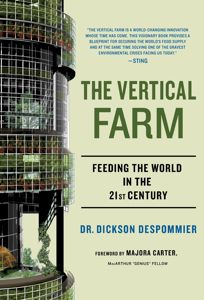
Dr. Despommier’s book.
DESPOMMIER: I don’t blame you. I think I can’t argue against a fresh picked strawberry in the wild. I love wild strawberries, and people don’t even know what a wild strawberry looks like, most of them. People criticize hydroponically grown-artificial- they call it artificial food- but I would just call it ‘indoor farming’.
They used to criticize a lot of the products produced by these farms because they didn’t taste good. They looked great, but when you got them to the table, they have nothing in common with the plants that you expected them to be. That was about ten or 15 years ago, and I think, once consumerism said, you know, ‘We don’t want plants that look good, we want plants that taste good,’ they went back and reexamined all of the qualities of plants.
They found out, very soon, that the reason why outdoor plants taste so good some years, but not every year, is because of the stresses that the plants have undergone during the growing season, particularly just before harvest. So, to know what the characteristics of the plants are to begin with, means that you can control it.
CURWOOD: What do traditional farmers think of this idea?
DESPOMMIER: You would expect I’d get a lot of hate mail. (Laughs). But, I get a lot of curious mail from farmers who- they want to know about the ease of hydroponic farming. They want to know about the productivity of it. They want to know about the yields. A lot of them have seen the light, in the sense that- how many good years in a row do you think that a farmer gets? I don’t care where they live and I don’t care what crop they’re growing, if you have ten years in a row I’ll be willing to be you that you don’t get more than four or five good years out of that. So, they’re looking for alternatives, they’re curious, they’re not threatened at all by this.

A vertical farm that Dr. Despommier helped conceptualize with Eric Ellingsen. (Photo: Eric Ellingsen and Dr. Dickson Despommier.)
CURWOOD: So, where’s the natural connection to the land and the earth for people in this?
DESPOMMIER: Yeah. There’s no natural connection to the earth. And, I must qualify that statement by saying that since farming is only 12,000 years old, and since we are, at least in terms of evolution, about 200,000 years old- farming is a really very recent addition to the human technology tool chest. And, let’s say for instance that it’s not possible to address climate issues, the climate just keeps getting worse. You know what happens to farming?
For every degree of increase in the average temperature of the planet’s atmosphere, it’s estimated we lose about ten percent of the agriable land on this planet. If that continues up to five degrees, you can see the consequences would be horrible for an ever-increasing population of people unless we learn how to farm in another way. So, the choices are almost zero.
I think we have to address ‘how can a city live like an ecosystem?’ That’s the bottom line for this whole project, is to make food production at the center of an ecological behavior pattern, and make them imitate the balanced ecosystems that are still left.
GELLERMAN: Dickson Despommier talking with LOE’s Steve Curwood. The book is “The Vertical Farm: Feeding the World in the 21st Century.”
Related link:
Learn more about the vertical farm
SNAP to the Farmers’ Market

A sign at the market advertising the Boston Bounty Buck program. (Photo: The Food Project)
GELLERMAN: The Thankgiving season is near – and yet, for many families in the US, the economy gives little to be thankful for. At this year’s dinner they’ll have to do without many of the fixings and blessings of years past.
These days nearly forty-two million Americans receive monthly help from the federal program once known as food stamps. Today it’s SNAP—the Supplemental Nutrition Assistance Program. Now, some cities are also trying to help.
LOE’s Jessica Ilyse Smith went shopping with some people receiving SNAP benefits- trying to balance a healthy diet with limited incomes.
[FARMERS’ MARKET SFX]
SMITH: On a recent afternoon the farmers’ market in Boston’s Copley Square is bustling with energy.
WOMAN: Do you want me to lift that bag up for ya?
[SOUNDS OF BAGGING AND BEEPING REGISTER]
SMITH: Today a group from the Boston Living Center is on a field trip.

Boston Bounty Bucks. (Photo: The Food Project)
HANSEN: We decided to come to the market today to learn how to use the food stamps and also use the Boston Bounty Bucks.
SMITH: Amber Hansen is the Boston Living Center’s registered dietician. She organized this outing to help the Center’s HIV positive members shop for produce using Bounty Bucks—the city’s program that doubles Federal SNAP benefits. It’s a dollar-for-dollar match up to ten dollars.
HANSEN: Do you want some cauliflower, or are you good?
CARLOS: how much is it?
HANSEN: Four dollars a pound. You could roast it with olive oil, garlic and salt. If you just chop it up. And then put some oil on it. Do you have olive oil or canola oil even? Both are healthy, good fats.
SMITH: Hansen gives Carlos tips on how to choose and cook his produce.
For Carlos and others living with compromised immune systems, fresh fruits and vegetables are especially important for their nutrition. Janet’s another member of the Boston Living Center.
JANET: When you’re living with HIV even though now, with the medicines a lot of people are living longer, but it’s very important to take care of yourself. Good nutrition is kind of a way to fight back.

SMITH: But fresh produce can be prohibitively expensive. Boston Bounty Bucks is trying to make healthy food more attainable for low-income residents. Edith Murnane is Boston’s director of food initiatives. When I visited her at her office in City Hall she told me this program is all about accessibility.
MURNANE: Farmer’s markets are a really interesting way to get fruits and vegetables into the inner city. I’m not only talking about physical accessibility, but it’s really economic accessibility and the Boston Bounty Bucks really gets at that.
SMITH: The program also helps out farmers.
MURNANE: It makes it economically viable for a farmer to come to the inner city. It makes it economically feasible.
SMITH: There are now 21 farmers’ markets that participate in the program—Murnane says this shows the city’s strong commitment to public health.
[FARMER’S MARKET SFX]
SMITH: The program is helping the city’s farmers’ markets accommodate SNAP users by providing grants for new technology. Lee Piper is the assistant farm manager at the Copley Square Market.
PIPER: We have a wireless terminal here at the market, so we can take your EBT card and swipe it through.
SMITH: The terminal logs on to each person’s SNAP benefits and matches up to ten dollars in Bounty Bucks. Piper shows Living Center members how to use their Electronic Benefit Transfer, or EBT cards.

A sign at the market advertising the Boston Bounty Buck program. (Photo: The Food Project)
PIPER: So I swipe this.
[BEEP OF MACHINE]
PIPER: Now, you need to enter your 4-digit pin number.
[BEEPS OF PIN, SOUND OF PAPER ROLLING OUT AND RIPPING]
SMITH: Piper hands Carlos his receipt and counts out 20 Bounty Bucks.
PIPER: 16,17,18,19, and 20. So that’s what you can spend.
CARLOS: Alright.
SMITH: Armed with his 20 Bounty Bucks, Carlos decides what to buy.
CARLOS: What I would like to buy…se llama? Collard? Collard greens. I love romaine lechuga, lettuce.

Using a SNAP EBT card at the farmers’ market. (Photo: The Food Project)
SMITH: Carrying bags of lettuce, collard greens, onions and mushrooms, Carlos gets in line to pay.
WOMAN: Do you want me to lift that bag up for you?
[SOUNDS OF BAGGING]
CASHIER: 13.75 is your total.
CARLOS: Gracias, thank you!
HANSEN: So the Bounty Bucks are a big help!
CARLOS: Oh my god!
HANSEN: Yeah! Right?
CARLOS: Yes. This is like for me seven dollars. 50% discount, 20 dollars for ten dollars! And I’m more positive that I come back more often.

A Bounty Buck.
SMITH: That’s exactly why Boston sponsors Bounty Bucks—to have customers return to the market throughout the growing season and eat more fruits and vegetables. The program has become a model for other cities. Farmers’ markets around the country are starting to add EBT stations and a few other programs offer financial incentives. The goals are the same: to improve health and nutrition in traditionally underserved populations.
[MARKET SOUNDS]
WOMAN: How many pounds is that? This is one…
SMITH: For Living on Earth, I’m Jessica Ilyse Smith.
WOMAN: So we could just get a couple? They really are delicious…
[MUSIC: Hugh Masakela “The Market Place” from Live At The Market Theater (Four Quarters Records 2007)]
Related links:
- Learn more about Boston Bounty Bucks
- Learn more about the Boston Living Center
GELLERMAN: Coming up – a novel way to protect groundwater. That’s just ahead on Living on Earth.
[CUT-AWAY MUSIC: Monty Alexander: “People Make The World Go Round” from Monty Meets Sly & Robby (Telarc Records 2000)]
Listener Letters
GELLERMAN: It’s Living on Earth, I’m Bruce Gellerman.
[MUSIC: Michigan Groundwater: Orgone “Duck And Cover” from Killon Floor (Ubiquity Records 2007)]
GELLERMAN: Time now to open the L-O-E mail. A few weeks ago we reported on a new international agreement designed to cut the emission of greenhouse gases from jet airplanes. In our interview with Sarah Burt from Earthjustice, she told us things in the sky could be a lot more efficient.
BURT: For example, we use, in the United States, a ground based navigation system, which means that aircraft actually have to zigzag across the sky, so that they have to lower their altitude to make contact with navigation systems on the ground and then go back to higher altitude again. Whereas if we had a satellite-based navigation system, they'd be able to fly at a more constant altitude, which would be much more efficient.
GELLERMAN: Many LOE listener including Richard Rhoton of Pittsburgh zagged when Sarah Burt zigged. “This is utterly false”, writes Mr. Rhoton. “No changes in altitude are required for proper navigation”. Well, to help us straighten up and fly right we called Paul Takemoto, of the Federal Aviation Administration. Seems planes don’t need to fly up and down to make contact with ground control, but they do “gently zig-zag” from one directional beacon to the next.
TAKEMOTO: So if you look at their route from a distance it’s essentially a straight line. But as you get closer and closer you’ll see that there are actually geometric edges to that line because they’re flying from one ground based nav aid to the next.
GELLERMAN: And Paul Takemoto says in the works is that satellite system that will smooth things out in the future. Thanks for setting us straight, Paul!
Our interview with super- safe, fuel-efficient champion trucker Carl Krites drove many listeners to send in their fuel-saving tips. Steve emailed, “ I set my cruise control at 60 and let the world buzz by. I am in no hurry. I find myself with the same crowd at the next light anyway, they’ve just been sitting there longer.”
And we got this comment from Alan Bau who tunes in to KRCC in Colorado Springs: “ I never drive around in a shopping center trying to get the closest parking space to the entrance. I take the space at the end of the row of cars and park. If I can pull through, I do, so I don't waste fuel backing out. Then I walk to the entrance. It may be a few more steps, but I save time and don't waste fuel.”
And as promised, we’re sending out official, LOE tire gauges to those whose fuel saving tips we used on the air. And if something we say gets your pressure up, or lets you down, let us know. Our email address is comments at L-O-E dot org. That’s comments at L-O-E dot O-R-G. or go to our Facebook page – it’s PRI’s Living on Earth.
Protecting Abundant Water

The White River in western Michigan, near the site where Nestle wanted to set up a water bottling plant. (Photo: Andrew Stelzer)
GELLERMAN: Michigan is awash in water. There are the Great Lakes of course - loads of streams and rivers, and an underground aquifer flowing with tens of billions of gallons of water a day. But the groundwater only seems endless. So when food giant, Nestle, announced plans to tap and bottle underground water in western Michigan, many residents became worried, and decided to act. And as Andrew Stelzer reports there’s now a growing movement to turn Michigan’s groundwater into a public trust…owned by state residents.
[WAVES ON LAKE MICHIGAN]
STELZER: For Michiganders, getaways on the shores of lake Michigan are practically a birthright. Summers it’s to escape blazing Midwestern heat. In the colder months its a haven for cross country skiing, hiking and ice fishing. And the same water that fills the lakes, makes Western Michigan farm country—a top Cherry and apple producer.
[CLANK OF WELL]
SMELTZER: See that’s…the well is in the ground…the pump and everything is in the hole down there almost 190 feet …so lemme get some water running…
[WATER RUNNING OUT OF WELL]
STELZER: Dave Smeltzer owns and operates Per-Clin orchards, an apple and cherry farm about 5 miles from Lake Michigan in Bear Lake. Smeltzer estimates he uses about 1.7 million gallons of well water a year, to irrigate his fields, and cool his cherries after they’re picked. There’s so much water under his land, his two wells have never run dry in 50 years. And he has no concern that the future will be any different, even for his neighbors, who run larger operations.
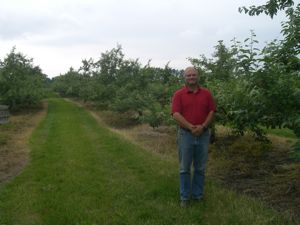
Dave Smeltzer, owner of Per-Clin Orchards, among his apple trees. (Photo: Andrew Stelzer)
SMELTZER: Some of these guys are running their wells constantly. I can’t imagine how much withdrawal, and yet there's still water, there's still water. It's recharged, Lake Michigan, the level of Lake Michigan is not dropping, there's water available for us to use. We need to understand that water is renewable, just like trees. You can plant trees, it rains, water is renewable, it's always there.
STELZER: Smeltzer’s confidence in an infinite water supply is pretty common among Michiganders. Many towns around here don’t even have water systems, everyone just digs a well and gets their water off their own land—for free. But a couple of bottled water plants have brought the question of water regulation and use to a head. The Nestle company wanted to extract water from a shallow stream for its Ice Mountain brand.
[BIRDS CHIRPING]
PEASLEY: They were talking about pumping over a hundred thousand maybe quarter of a million gallons a day.
STELZER: Jay Peasley is a board member on the White River Watershed Partnership and was part of the group that sued Nestle.
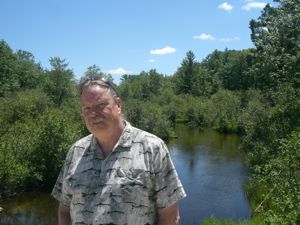
Jay Peasley at the White River, near where Nestle wanted to set up a water bottling plant. (Photo: Andrew Stelzer)
PEASLEY: So, you’re talking about cutting the flow by, I think it was 20% or something, and it's a blue ribbon trout steam up here, they have native brookies in it. So, not only would the fish be impacted, so would everything else that lives here - the goldfinch, the eagles, just everything that live in this area.
STELZER: Amid an uproar, Nestle had to cancel its White River plans. At another Nestle site, a judge agreed the company’s project would sharply reduce the flow of the little Muskegan River. But, the ruling also changed the equation for such projects. Before, you could use water until it affected your neighbor. Now, the economic benefit of extracting groundwater could outweigh ecological harm. That got the attention of State Representative Dan Scripps, whose district covers 100 miles of Lake Michigan coast.
SCRIPPS: Even though you're causing harm to the resource, even though it's not sustainable and you're hurting your neighbor’s ability to access their well and their water- now, if you can show a large enough profit, we may let you do it anyway. Well, that, I think, put us on a slippery slope.
STELZER: So Scripps has proposed a solution in the state legislature. He wants to put Michigan’s groundwater into what’s called a ‘Public Trust’. It’s a designation that already protects most rivers, lakes, and streams in Michigan. With this bill, the water underground would now also be owned by all residents of Michigan and protected by the state. A hedge perhaps, against a future, water-limited world.
OLSEN: The statistics globally are that there's a global water crisis and the scarcity and demand is going to strip supply by 30 percent in, what, 20 or 30 years- in the most recent reports that I’ve seen..
STELZER: That’s Attorney Jim Olsen. He argued the case against Nestle.
OLSEN: So, those people have their heads in the sand to believe that we are, somehow- have this unlimited supply and the rest of the world won't come at it when they're thirsty.
STELZER: Olsen’s concerned about a day when climate change could turn this region into a no-cost freshwater fountain for the world.
OLSEN: There will be very little that people will be able to do to stop the transport of water out of the Great Lakes Basin.
STELZER: But not all Michiganders are concerned about a run on the state’s water supply by drought-driven outsiders. This public trust idea is seen as a threat by some who worry the law would give the government too much control, and lead to the taxing and regulation of people’s wells. People like orchard owner Dave Smeltzer.

Eric Neubecker with one of his company's well drilling rigs. (Photo: Andrew Stelzer)
SMELTZER: I just fundamentally and philosophically disagree with Representative Scripps on this issue. Because, there's adequate protection for water in Michigan now, so this additional layer of legislation intrudes more into a personal use of the water and the private property rights thing.
[SOUND OF WELL DRILLING MACHINE]
STELZER: Additionally, industries that use large amounts of water are concerned the law might prevent them from getting it for free, and that could have an economic ripple effect. Eric Neubecker is a geologist at his family’s well digging business, the Ramer Company, in Marne, Michigan. They drill 250 wells every year.
NEUBECKER: The abundant ground water in the state of Michigan is one reason why the farmers, the fruit growers are here. And now, if we make it unattractive for them to be in business here, that would have an adverse effect on our business because there would be fewer wells to work on, fewer wells to drill. It would just have a total negative effect on the entire economy.
STELZER: Representative Scripps says his bill would not result in any taxes at all. He says it’s essential that the Great Lakes water, which accounts for more than 20 percent of the world’s surface freshwater supply, is protected at all stages, not just above ground where we can see it.

The White River in western Michigan, near the site where Nestle wanted to set up a water bottling plant. (Photo: Andrew Stelzer)
SCRIPPS: If we don’t have protections on every stage of the water cycle, the truth is, that we don’t really have protections on the Great Lakes, because they're all connected….Because a private right to water, if the water is not there doesn’t mean a whole lot.
STELZER: Vermont and Hawaii already hold groundwater in a kind of trust, and the results there have been positive. But, Michigan has never suffered a significant water shortage, so preventing a future one will likely be a hard sell in the state legislature next year. For Living on Earth, I’m Andrew Stelzer, in Benzie County, Michigan.
Related links:
- Business Perspective on MI Water
- Michigan Citizens for Water Conservation
- FLOW for water--Jim Olson's organization
- Visit this blog of Great Lakes water law
[MUSIC: Midnight Oil “Arctic World” from Diesel And Dust (Sony Music 1988)]
Carbon Credit Card
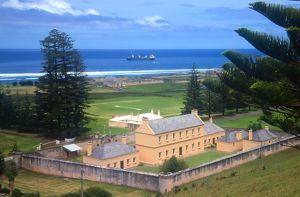
The prison island once known as “Hell in Paradise” may show us how individuals can slow the planet’s warming. (source: wikimedia commons)
GELLERMAN: It’s a two hour jet flight from Brisbane, Australia to what was once called “hell in paradise”. Remote Norfolk Island is 13 square miles of volcanic rock rising out of the crystal clear South Pacific. It’s home to two thousand people and one major tourist attraction.
Each year 30 thousand tourists come to see what’s left of Norfolk Island’s 18th century penal colony; a deplorable place where inhumane conditions earned Norfolk its nickname. But Norfolk Island is now working on a new reputation.
Scientists plan to turn it into a living laboratory - a giant experiment designed to solve two of the world’s most vexing problems: global warming and obesity. The idea: “a carbon credit card” that would help Norfolk Islanders reduce their green house gas emissions and the size of their waists.
Dr. Garry Egger is in charge of the plan. He’s a professor of lifestyle medicine and applied health promotion at Southern Cross University in New South Wales. Hi Professor!
EGGAR: G’day Bruce!
GELLERMAN: So, tell me about this card.
EGGAR: Ultimately there would be an electronic card and that electronic card may be on an existing credit card, or it may be a totally stand alone card. So, that when somebody goes to buy their petrol or their power, not only do they pay in money, but it comes off the carbon units that they’ve been allocated, for free, at the start of a set period.
And, let’s say that after they’ve paid all their power for that period, they’ve got a hundred credits left, they can then cash that hundred in at the carbon bank and make money over it, and hopefully, improving their health over the long term.

The prison island once known as “Hell in Paradise” may show us how individuals can slow the planet’s warming. (source: wikimedia commons)
GELLERMAN: How could it improve their health?
EGGAR: Well, for example, if you are walking, or riding push-bike instead of riding in your car, presumably by not using the carbon you will increase your physical activity level which is going to help the health. But ultimately, we also help to look at foods and we hope to put a carbon price and a health price on foods so that carbon units are detracted for unhealthy and high-carbon emitting food.
GELLERMAN: So, if I were a Norfolk Islander, and I had one of these carbon credit cards, if I reduced my purchase of gas, my credits get stored in the card and I can even get some money, and that’s paid to me and that’s a good thing for the planet and that’s a good thing for me.
EGGAR: Exactly. That’s the way it’s designed. Now, long term, it’s quite possible too that the people who don’t reduce their emissions and in fact become very profligate in their use of energy, who are more likely to be the rich, may have to go and buy more units as the units go down each year- as the number of units go down.
But that’s still to be determined by the islanders. We haven’t instituted that, we haven’t suggested that at this stage. We want to make it a totally positive approach, because one of the things that we are testing is whether the public will accept it. Because if it’s not acceptable to the public, then it’s unlikely to be picked up in this day and age by any government, anywhere around the world.
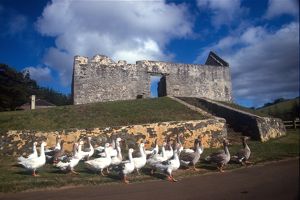
Norfolk is home to 2000 but 30,000 visitors come to see its prison ruins every year. The experimenters hope that the incentives from the carbon credit card will also draw tourists. (source: wikimedia commons)
GELLERMAN: So, basically, you’re reducing your carbon footprint and you’re waist size.
EGGAR: Yup, that’s right.
GELLERMAN: Are people that live on this island, um, overly obese?
EGGAR: They’re about the same as the rest of Australia, and Australia is not far behind the United States in terms of obesity. So, we’re up in the top six or seven in the world. It happens with rich countries. As a country gets richer, it tends to get fatter.
GELLERMAN: But it seems to me one of the outcomes of this is that you reduce climate change gasses and nothing changes with obesity.
EGGAR: That’s another possibility, of course. For example, if you got people out of their gas driven cars and into electric cars, that may reduce the carbon emissions, but it’s not going to help their obesity, because they’ll still be driving around the town.
But, as I say, this is just a trial, it has to be tested and this is the best way to test it- on a self-contained island. And it has to be democratic, in this day and age as well, it can’t be imposed, it has to be run by the islanders themselves. The reason I’m going out there tomorrow is that we’ve been attacked by some of the far right here, with the climate change. One particular shop-jock here in Australia, his name is Andrew Bolt, and he’s a bit similar to your Rush Limbaugh.
GELLERMAN: Why don’t we see if we can tune some of that in and play it for our listeners:
[CLIP OF BOLT]
BOLT: Their ration credits runs out and you’ve made food too expensive for them to buy, what happens to them?
EGGARS: Well, again, they get money back from doing the right thing.
BOLT: No, but they’ve done the wrong thing, because that’s why their fat and poor.
GELLERMAN: Now, this shop-jock, he’s kind of a right wing radio guy?
EGGARS: He did an interview with me, in which he didn’t ask the questions about it being voluntary and being run by the islanders and so on. And, as a result, he attacked me personally.
GELLERMAN: So, your job now is to sell it to the islanders?
EGGARS: Well, we had sold it to the islanders. I mean, that’s the whole thing, this is not something that has been imposed, it’s been…we’ve been a year now in discussion with the Parliament and with the people on the island. But, up until such time there was an adversary action, the islanders were only sort of minimally interested. And, now, they’re more interested and we have explain it in much more detail to them.
GELLERMAN: So what are you going to call this carbon credit card?
EGGAR: That, again, is up to the islanders. They came up with the name for the project which is a niche project, which is N-I-C-H-E, which is Norfolk Island Carbon and Health Evaluation Programme. And, it fits nicely, because it is a niche island, and this is a niche program. And, it’s a test as I keep saying.
But again, I go back to this notion, and I plead ignorance to some extent on the whole climate change issue, in the sense that we are health scientists who are looking to do something about the major health epidemics of the day- that is obesity and type 2 diabetes- but we are looking to do it within a context of being able to also reduce pollution and emissions, which no one has looked at to date.
GELLERMAN: Dr. Eggar good luck!
EGGAR: Thanks very much, Bruce.
GELLERMAN: Garry Egger is a professor of lifestyle medicine at Southern Cross University in New South Wales.
EarthEar

Budgie Quintet (Photo: ©Listening Earth)
GELLERMAN: We leave you this week surrounded by budgies.

Budgie Quintet (Photo: ©Listening Earth)
[SOUND OF BUDGIES]
GELLERMAN: The deserts of Australia are home to the Budgerigar. These wild parakeets wake at dawn, chatter amiably and then flutter off in groups to feast on seeds. Andrew Skeoch found these colorful birds frolicking down under in the Macdonnel Ranges in Central Australia and recorded them for his CD called “Happy Budgies.”
Related link:
Happy Budgies – The Sound of Wild Budgerigars
GELLERMAN: Living on Earth is produced by the World Media Foundation. Our crew includes Bobby Bascomb, Eileen Bolinsky, Ingrid Lobet, Helen Palmer, Jessica Ilyse Smith, Ike Sriskandarajah, Mitra Taj, and Jeff Young, with help from Sarah Calkins, Sammy Sousa, and Emily Guerin. Our interns are Nora Doyle-Burr and Honah Liles. We had engineering help this week from Dana Chisholm. Jeff Turton is our technical director. Alison Lirish Dean composed our themes. You can find us anytime at L-O-E dot org – and while you’re online, check out our sister program, Planet Harmony.
Planet Harmony welcomes all and pays special attention to stories affecting communities of color. Log on and join the discussion at my planet harmony dot com. And don’t forget to check out our Facebook page, PRI’s Living on Earth. Steve Curwood is LOE’s executive producer. I’m Bruce Gellerman. Thanks for listening.
ANNOUNCER: Funding for Living On Earth comes from the National Science Foundation supporting coverage of emerging science. And Stonyfield farm, organic yogurt and smoothies. Stonyfield pays its farmers not to use artificial growth hormones on their cows. Details at Stonyfield dot com. Support also comes from you, our listeners. The Ford Foundation, The Town Creek Foundation, The Oak Foundation—supporting coverage of climate change and marine issues. And Pax World Mutual Funds, integrating environmental, social, and governance factors into investment analysis and decision making. On the web at Pax world dot com. Pax World for tomorrow.
ANNOUNCER 2: PRI – Public Radio International
Living on Earth wants to hear from you!
Living on Earth
62 Calef Highway, Suite 212
Lee, NH 03861
Telephone: 617-287-4121
E-mail: comments@loe.org
Newsletter [Click here]
Donate to Living on Earth!
Living on Earth is an independent media program and relies entirely on contributions from listeners and institutions supporting public service. Please donate now to preserve an independent environmental voice.
NewsletterLiving on Earth offers a weekly delivery of the show's rundown to your mailbox. Sign up for our newsletter today!
 Sailors For The Sea: Be the change you want to sea.
Sailors For The Sea: Be the change you want to sea.
 The Grantham Foundation for the Protection of the Environment: Committed to protecting and improving the health of the global environment.
The Grantham Foundation for the Protection of the Environment: Committed to protecting and improving the health of the global environment.
 Contribute to Living on Earth and receive, as our gift to you, an archival print of one of Mark Seth Lender's extraordinary wildlife photographs. Follow the link to see Mark's current collection of photographs.
Contribute to Living on Earth and receive, as our gift to you, an archival print of one of Mark Seth Lender's extraordinary wildlife photographs. Follow the link to see Mark's current collection of photographs.
 Buy a signed copy of Mark Seth Lender's book Smeagull the Seagull & support Living on Earth
Buy a signed copy of Mark Seth Lender's book Smeagull the Seagull & support Living on Earth

